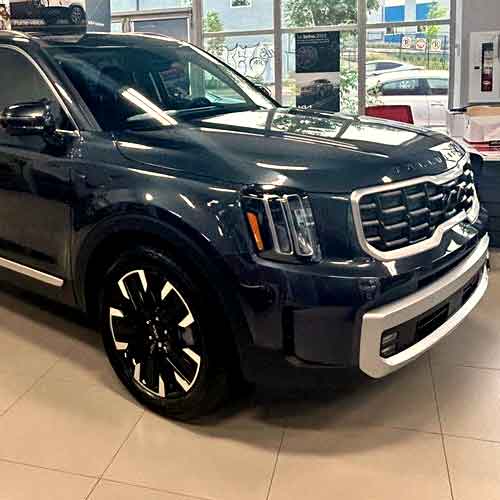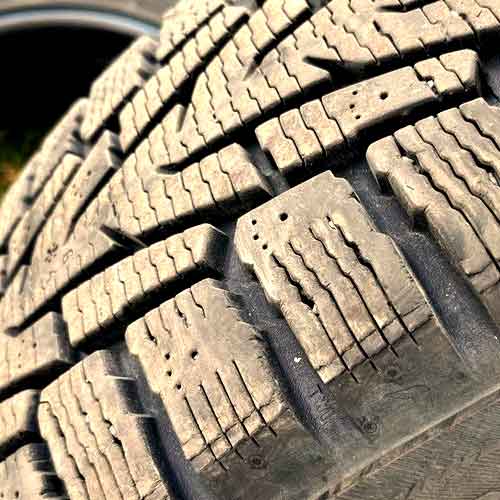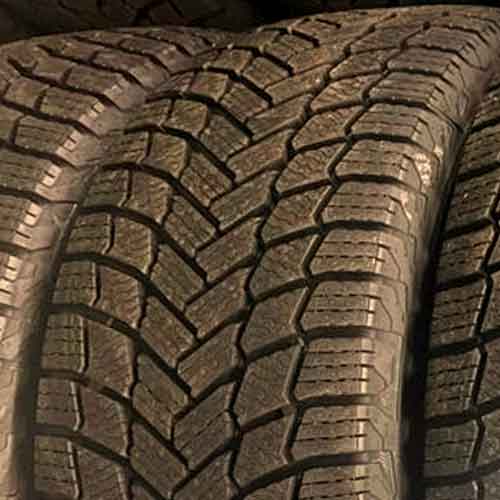Both the Michelin X Ice Snow and the Nokian Nordman 7 shine in the winter tire category, each mastering different domains of performance, efficiency, and smoothness, thus giving a wide gamut of choices for different user predilections and roadway conditions.

Table of Contents
Sizes Info
The Michelin X-Ice Snow (review) comes in 125 total sizes in 15 to 22 inches. They have following specs.
- Speed ratings: T and H.
- Load ratings: SL and XL.
- Tread depth: 10.5/32″ on all.
- Weight: 16 to 40 lbs.
- Tread warranty: 40k miles.
On the other side, the Nokian Nordman 7 (review) comes in 34 sizes in 13 to 17 inches rims, with following specs.
- Speed ratings: T only.
- Load ratings: SL and XL.
- Tread depth: 13/32″ on all.
- Weight: 15 to 27 lbs.
- Tread warranty: None.
Tread Pattern
Starting with the Nokian Nordman 7, the tire while boasting a somewhat intricate design, maintains its directional quality.

The central region of the tire is particularly intriguing, hence our discussion commences from this point.
Here, you’ll find two ribs, with the middle one almost forming a continuous line.
The central rib mimics a vine densely populated with thick leaves, where each lug presents hefty in-groove notches.
These lugs further stand out due to their biting edges and an abundant array of siping.
The surrounding lugs continue this pattern, but they additionally showcase sharp, off-set edges.
As we move towards the shoulders, the design becomes more streamlined. Slanted lugs make an appearance, richly imbued with tread features such as multiple siping designs, off-set edges, and stud holes.
Alternatively, the Michelin X-Ice Snow also shows up with a distinct and directional tread pattern.

Four circumferential indentations are constructed from four ribs, which are subdivided into six.
The central groove, being the most narrow and complex, is composed of two ribs embedded with blocks filled with multiple sharp edges, wave-sipes, and chamfered sides.
The surrounding lugs are of a similar design but are spaced more broadly and are lesser in size.
All the blocks, inclusive of the shoulders, are interconnected on a base layer of rubber, providing stability as the tire turns.
The shoulder blocks possess slightly milder edges, a mildly squared shape, and have rectilinear lateral sipes and notches on their edges.
Wet Performance
Tire grip on wet surfaces heavily relies on the number of grooves or sipes a tire has, as well as the ability of the tread rubber to absorb water.
Despite both tires featuring ample grooves to displace water and prevent hydroplaning, the Michelin X-Ice Snow slightly outperforms.
This tire incorporates diverse types of sipes adept at absorbing and channeling water, enhancing its grip on damp roads.
The presence of numerous tightly-packed, sturdy yet flexible sipes bolsters its performance around corners.
Conversely, the Nokian Nordman 7, though not lagging far behind, exhibits less aggressive siping and a stiffer rubber compound.
Winner: Michelin.
Snow Grip
In snowy conditions, the Nokian Nordman 7 takes the lead, particularly when navigating light, fluffy snow, (although it falls short on icy or compacted snow, which I’ll talk about in its separate section).
This superior performance can be attributed to its tread design, featuring abundant in-groove notches and voids which act as snow trappers, thus enhancing ground contact via the captured snow.
This is due to snow’s better adherence to itself than to rubber.
The Michelin X-Ice Snow, with its less spacious and simpler tread design, fails to offer as effective snow-to-snow contact, especially in heavy snow.
Winner: Nokian.
Vibration Dampening
Tires serve as the vehicle’s initial barrier against road irregularities, effectively acting as supplementary suspension systems.
The Michelin X-Ice Snow takes the lead in this aspect with its innovative tread compound. This compound adeptly manages uneven surfaces, absorbing road disturbances and delivering a remarkably smoother ride.
Conversely, while the Nordman 7’s stiffer rubber falls short in this aspect, though it excels in ride quietness, which is also a great contributing part to overall ride comfort.
Winner: Michelin.
Noise Generation
Tire noise primarily emanates from two sources. One, air colliding with the tread walls (mainly entering through shoulder voids) and, and two, in-groove resonance caused by echoing noise within the tread.
The Michelin X-Ice Snow, with its closed-up shoulder voids, restricts air entry.
However, its softer rubber exacerbates in-groove resonance, making it comparatively louder.
In contrast, the Nokian Nordman 7 manages to be quieter thanks to its superior pitch sequencing technology.
This technology modifies the tread block geometry, causing various tones to be produced as air particles collide with the tread. These different tones then work to cancel each other out, reducing overall noise.
Winner: Nokian.
Ice Traction
On ice-clad surfaces where numerous tiny “biters” are crucial, the Michelin X-Ice Snow shines, courtesy of its angled slits and multi-directional snow vices.
Alongside the tire’s more robust siping, these elements facilitate faster braking and enhanced handling.
The tire’s multi-angled sipes further augment grip in every direction, significantly boosting traction.
The Nokian Nordman 7, however, lags behind due to its wider tread gaps and limited notches, and its less aggressive siping pattern means fewer “teeth” biting into the ice.
Winner: Michelin.
Dry Gripping
The efficacy of the directional grip hinges predominantly on the central tread area where the majority of the tire’s load is concentrated during linear cruising.
Keeping this in mind, the Nokian Nordman 7 offers superior performance. Both tires exhibit continuous central ribs that maintain constant road contact, but the Nordman 7 edges ahead with its more cohesive pattern extending to the surrounding lugs.
This results in a noteworthy reduction in braking distance, by an average of 4 feet in tests, compared to its counterpart.
Winner: Nokian.
Dry Handling
The tire’s ability to handle or maintain lateral grip depends largely on the shoulder lug design and overall tread flexibility.
Consequently, both tires showcase comparable lateral g-forces and lap times during testing.
Both present similar shoulder footprints, ensuring nearly identical contact patches, and exhibit comparable steering response and susceptibility to oversteering and understeering.
Winner: Both!
Tread and Fuel Usage
The relationship between tread life and fuel economy primarily hinges on rolling resistance, significantly influenced by the tire’s weight, tread composition, and design.
In terms of fuel efficiency, the Michelin X-Ice Snow emerges superior, due to its more streamlined lugs and less aggressive tread voids, particularly centrally. This allows for a smoother, uninterrupted central rib, minimizing obstacles during linear rolling and thus enhancing fuel economy.
However, when considering tread life, the Nokian Nordman 7 excels, thanks to its harder tread compound and deeper tread.
Tread life is shaped by two factors: rubber wear rate and the time taken to reach a critical wear level. Benefiting from lighter weight and a tougher rubber compound, the Nordman 7 resists wear more effectively.
Its deeper tread implies a longer duration to reach the legally required 2/32″ tread depth, hence extending its lifespan.
Winner: Michelin in terms of fuel, and Nordman in terms of tread life.
To Sum Up
This rigorous comparison has highlighted the strengths of both tires, each outperforming in different categories.
The Michelin X-Ice Snow excels with superior wet traction, vibration dampening, and ice performance, whereas the Nordman 7 dominates in snow performance, noise reduction, and dry traction.
Intriguingly, both tires present stiff competition in dry handling. Moreover, while Michelin X-Ice Snow excels in fuel economy, the Nordman 7 takes the prize for tread life.
So overall, the final choice will rely on individual needs and the specific conditions that drivers more frequently encounter.